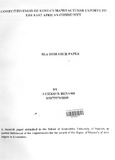| dc.description.abstract | Despite policy efforts to diversify exports, Kenya’s export base is still largely dominated by primary products from the agricultural sector. Trade and commodity concentration has led to export earnings fluctuations which eventually leads to the problem of balance of payments, budgets deficits and does not permit future systematic economic planning. With dwindling fortunes in the agricultural sector due to vagaries of weather among others, it is imperative for policy makers to deal with the issue of diversification of the country’s exports. This will help cushion the country against shocks arising from the instability in the foreign exchange markets especially for the primary products. This strategy will contribute to the development of new export markets for manufactured goods destined for the EAC.
By using panel data this paper investigated factors influencing competitiveness of Kenya’s manufactured exports to the EAC. The primary concern of policy makers and macroeconomic analysts is what factors promote or inhibit the flow of Kenya’s manufactured exports to the EAC.
The findings indicate that trade policy, captured by openness and nominal exchange has a large effect on export competitiveness, their coefficients are large. However, fixed capital formation which is a proxy for trade facilitation has a small effect on export competitiveness. Infrastructural development is not playing the rightful role in releasing export potential of the trading bloc; hence is a bottle neck on the export supply side.
The national government should have a policy of infrastructural investment like construction of corridors and upgrading of railway system to increase accessibility and ease the movement of manufactured exports. Unit labour cost has a negative effect on export competiveness. EAC member countries are labour abundant and therefore productivity of labour is more important than numbers. The member countries should invest in research and development, health care, education and capital equipment to increase labour productivity that lower unit labour cost thereby increasing competitiveness of manufactured goods.
Therefore, manufactured exports are important for Kenya’s export matrix. It is therefore critical for the GOK and policy makers to work towards accelerating policies that will improve the volume of exports of manufactured goods to the EAC while drawing lessons from Asian tigers. | en_US |



